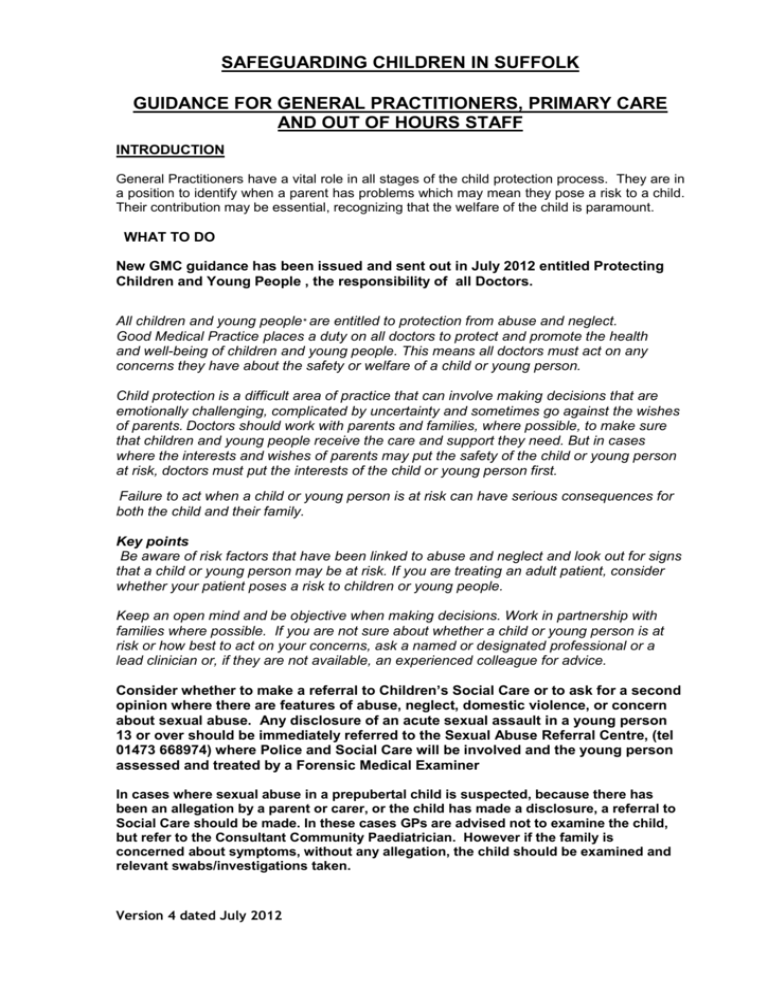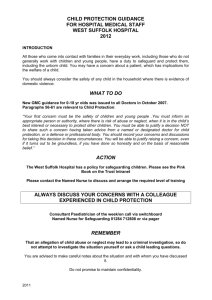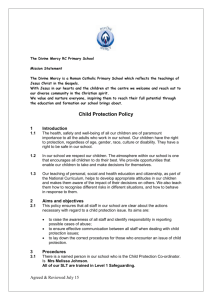Child Protection Guidance for General Practitioners
advertisement

SAFEGUARDING CHILDREN IN SUFFOLK GUIDANCE FOR GENERAL PRACTITIONERS, PRIMARY CARE AND OUT OF HOURS STAFF INTRODUCTION General Practitioners have a vital role in all stages of the child protection process. They are in a position to identify when a parent has problems which may mean they pose a risk to a child. Their contribution may be essential, recognizing that the welfare of the child is paramount. WHAT TO DO New GMC guidance has been issued and sent out in July 2012 entitled Protecting Children and Young People , the responsibility of all Doctors. All children and young people* are entitled to protection from abuse and neglect. Good Medical Practice places a duty on all doctors to protect and promote the health and well-being of children and young people. This means all doctors must act on any concerns they have about the safety or welfare of a child or young person. Child protection is a difficult area of practice that can involve making decisions that are emotionally challenging, complicated by uncertainty and sometimes go against the wishes of parents. Doctors should work with parents and families, where possible, to make sure that children and young people receive the care and support they need. But in cases where the interests and wishes of parents may put the safety of the child or young person at risk, doctors must put the interests of the child or young person first. Failure to act when a child or young person is at risk can have serious consequences for both the child and their family. Key points Be aware of risk factors that have been linked to abuse and neglect and look out for signs that a child or young person may be at risk. If you are treating an adult patient, consider whether your patient poses a risk to children or young people. Keep an open mind and be objective when making decisions. Work in partnership with families where possible. If you are not sure about whether a child or young person is at risk or how best to act on your concerns, ask a named or designated professional or a lead clinician or, if they are not available, an experienced colleague for advice. Consider whether to make a referral to Children’s Social Care or to ask for a second opinion where there are features of abuse, neglect, domestic violence, or concern about sexual abuse. Any disclosure of an acute sexual assault in a young person 13 or over should be immediately referred to the Sexual Abuse Referral Centre, (tel 01473 668974) where Police and Social Care will be involved and the young person assessed and treated by a Forensic Medical Examiner In cases where sexual abuse in a prepubertal child is suspected, because there has been an allegation by a parent or carer, or the child has made a disclosure, a referral to Social Care should be made. In these cases GPs are advised not to examine the child, but refer to the Consultant Community Paediatrician. However if the family is concerned about symptoms, without any allegation, the child should be examined and relevant swabs/investigations taken. Version 4 dated July 2012 If you would like a second opinion, contact the Consultant Paediatrician on call by phone or if a child requires treatment /admission , send the child to hospital. Do not send the family to A/E without contacting the paediatricians in case they do not attend. In general, babies and those requiring investigation and treatment should be referred to the hospital, those with bruising, potential sexual abuse or more minor injuries will be seen by the Community Paediatricians . Always consider the safety of any children in the household where there is evidence of domestic violence, or any of the carers have mental health problems Avoid confronting the family but explain that you are concerned and are referring for a second opinion All NHS Trusts have a Named Doctor and Named Nurse for safeguarding. There are also Designated Doctors and a Nurse who work across the County and can be contacted for advice through the Safeguarding Department on 01473 264357. www.suffolkscb.org.uk Social Care Services Telephone Numbers: Customer First 0808 800 4005 Out of Hours 0808 800 4005 Professionals Number: 08456 066167 Fax No: 01449 723127 Postal address: Customer First, Suffolk County Council, PO Box 771, Needham Market, Ipswich, Suffolk IP6 8WB NORTH SUFFOLK The on call Paediatrician through James Paget Switchboard 01493 452452 EAST SUFFOLK The on call Paediatrician through Ipswich Hospital Switchboard 01473 712233 Consultant Community Paediatricians 01473 321209 WEST SUFFOLK The on call Paediatrician through WSH Switchboard 01284 713000 Consultant Community Paediatricians 01284 775075 T Paediatricians expect and welcome discussions with all referral agencies regarding concerns about children and provide a 24-hour on call Service across the County. Out of hours, contact the Hospital Switchboard for access to the on call Paediatrician. SHARING INFORMATION—GMC GUIDANCE JULY 2012 : You should normally discuss any concerns you have about a child’s or young person’s safety or welfare with their parents. You should only withhold information about your Version 4 dated July 2012 concerns, or about a decision to make a referral, if you believe that telling the parents may increase the risk of harm to the child or young person or anyone else. If this is difficult to judge, or you are not sure about the best way to approach the situation, you should ask for advice from a designated or named professional or a lead clinician or, if they are not available, an experienced colleague. When discussing your concerns with parents, you should explain that doctors have a professional duty to raise their concerns if they think a child or young person is at risk of abuse or neglect. You should explain what actions you intend to take, including if you are contacting the local authority children’s services. You should give the parents this information when you first become concerned about a child’s or young person’s safety or welfare and throughout a family’s involvement in child protection procedures. You must work with and communicate effectively with colleagues in your team and organisation and with other professionals and agencies. This includes health visitors, other nurses, social workers and the police. You should understand and respect the child protection roles, responsibilities, policies and practices of other agencies and professionals and cooperate with them. You must be clear about your own role and responsibilities in protecting children and young people, and be ready to explain this to colleagues and other professionals. You must tell an appropriate agency, such as children’s social care services, or the police, promptly if you are concerned that a child or young person is at risk of, or is suffering abuse or neglect unless it is not in their best interests to do. You do not need to be certain that the child or young person is at risk of significant harm to take this step. If a child or young person is at risk of, or is suffering, abuse or neglect, the possible consequences of not sharing relevant information will, in the overwhelming majority of cases, outweigh any harm that sharing your concerns with an appropriate agency might cause. When telling an appropriate agency about your concerns, you should provide information about both of the following: a the identities of the child or young person, their parents and any other person who may pose a risk to them b the reasons for your concerns, including information about the child’s or young person’s health, and any relevant information about their parents or carers. The GMC booklet gives clear guidance about issues of confidentiality and consent and your duties and responsibilities in this respect. There is also guidance on assessing capacity and determining who has parental responsibility for the child. MEDICAL RECORD KEEPING All action taken should be fully documented in the records, with accurate contemporaneous notes of allegations or remarks by child young person or parents. A recording must be made for all consultations of who attends with the child. Consultation with other colleagues should also be carefully recorded. There should be a clear means of identifying in the record, those children and their siblings , who are subject of a child protection plan, so that all health professionals in the practice are aware of this. All Safeguarding information should be scanned into the record of each child in the family. Details of the plan will be sent to each practice when there is confirmation Version 4 dated July 2012 that the patient is registered, through a response to the CP conference invitation. 1. INDICATORS FOR CONCERN Any unexplained bruise or mark in a non-mobile baby An episode of cyanosis or collapse Disclosure of abuse to GP either by child or parent Injuries inconsistent with the history given, or unexplained injuries Recurrent injuries Unexplained failure to thrive Features of neglect or emotional abuse Allegations or medical findings suggestive of sexual abuse Premature birth/young parents/multiple births Actual or suspected multiple episodes of domestic violence Parental drug and alcohol misuse 2. FACTORS IN THE HISTORY WHICH SHOULD AROUSE SUSPICION Inappropriate delay in seeking medical advice Multiple and mixed injuries Complicated history Apparent fabrication of symptoms Variable history Inappropriate parental reaction Abnormal interactions between child and parent Unusual degree of hostility or over-friendliness to staff Concerning comments made by the child 3. PARENTAL INDICATORS THAT MAY LEAD YOU TO HAVE CONCERNS REGARDING THE SAFETY OR WELFARE OF A CHILD Mental health difficulties Learning disorder difficulties History of sexual offending History of violence History of previous children being referred for child protection concerns or being removed under care order Parental fabricated illness Frequent visits to health professionals for advice – could be a cry for help PHYSICAL ABUSE Findings on examination which should arose suspicion and prompt referral Bruising of different ages in places where accidental causes are unlikely i.e. soft tissues/flexor surfaces of limbs Linear bruising/imprint bruising Scalds and burns which do not look accidental Bite marks Mouth injuries/torn frenulum Bilateral eye or ear injuries Head injuries incompatible with history obtained i.e. fall from low surface Abdominal bruising or injuries Genital bruising or injuries Any bruise in non-mobile baby which is unusual or unexplained Always refer non-mobile babies with unexplained bruises for a Paediatric opinion as they may have more serious underlying injuries Version 4 dated July 2012 NEGLECT Physical Developmental Behavioural In the infant: In the pre-school child: In the school child: In the teenager: Failure to thrive Significant weight loss Unexplained bruising Severe nappy rash Frequent hospital admissions Recurrent and persistent infections General delay Failure to gain weight/height Physical features of FTT Poor hygiene Failure to gain height/weight Poor hygiene Failure to gain height/weight or obese Poor general health Delayed puberty Poor hygiene Delayed language Poor attention Socially immature Learning difficulties Lack of self esteem Poor coping skills Emotional immaturity School failure Attachment disorder: anxious, avoidant Socially unresponsive Food scavenging Overactive Aggressive and impulsive Indiscriminate friendliness Seeks Physical comfort from strangers Food scavenging Poor relationships Overactive Aggressive Withdrawn Unusual patterns of defecation or urination Destructive Truancy Smoking Alcohol and substance misuse Sexual promiscuity Destructive behaviour PATTERNS OF EMOTIONAL ABUSE Rejecting: Isolating: Terrorising: Ignoring: Corrupting: The child’s needs are not acknowledged The child is excluded from normal social interaction The chills is verbally assaulted The child is deprived of essential stimulation The child is stimulated to engage in destructive anti-social behaviour The following age specific guidelines can be used: 0–1 Sleep/feeding problems, irritability, apathetic, dull, anxious attachments 1–3 As above + overactive, aggressive, attention deficit, language delay, indiscriminate affection, fearful and anxious, inability to play, anxious and ambivalent attachments 3–6 As above + peer relationship difficulties, attention seeking, clingy, school failure, poor social skills 6 – 12 As above though sleep and feeding problems may resolve inappropriate attachment to carers, rejected by peers, development of delinquent behaviours, truanting, wetting, soiling, stealing, bullying 12+ As above + depressions, escalated aggression, anxiety, self-harm, poor self-image, psychosomatic illness, drug and substance misuses, criminal activities SEXUAL ABUSE - Levels of concern: Low Suspicion: Medium Suspicion: High Suspicion: Version 4 dated July 2012 Recurrent UTIs Recurrent abdominal pain, headaches or other psychosomatic features Isolated observation of sexualised behaviour “Eccentric” sexual patterns of family interaction without other observable or reported symptoms Perineal itching, soreness, pain on micturition, discharge anal warts child hinting that there are secrets he/she cannot talk about psychiatric disturbances, mutism, anorexia nervosa, attempted suicide or deliberate self harm concern about inappropriate behavioural patterns with other children or adults Semen in vagina, anus or external genitalia pregnancy in a minor where identity of father is unknown/concealed signs of STDs repeated and frequent sexualised behaviour bruises, scratches or other injuries to genital or anal areas, or areas such as breast and lips laceration or scarring of anal mucosa into perianal skin Flowchart for Professionals working with Sexually Active Under 18’s Initial or Ongoing Contact with Young Person INITIAL ASSESSMENT OF RISK (based on information available) Consider: ▪ The young person, (including whether they appear to be under 13 because the law treats under 13s differently) ▪ The context of the consultation (including who else is present) ▪ Any information known or forthcoming about their partner ▪ Give advice, support/treatment in line with Fraser competency ▪ Young person should be kept advised of actions being taken where this is appropriate to do so ▪ Act in a timely way, avoiding and minimising delay, ensuring that at all stages you minimise risk of harm for both the young person and their sexual partner if she/he is at risk of harm Does this assessment leave you with? Immediate/imminent concern Some uncertainty No concerns (to young person or risk of young person abusing someone else) Seek immediate advice from Child Protection lead or Named/Designated Doctor, or go straight to next step Obtain more information on specific concerns Is he/she under 13? Further Guidance Needed Discuss with Child Protection lead or Named/Designated Doctor Yes No THEN Activate multi-agency Child Protection procedures, action accordingly and document reason for doing so OR document reason for not doing so Referral to Children & Young People’s Services Customer First/Child Protection Team Version 4 dated July 2012 Offer advice, support and treatment; document discussion WHAT TO DO FOLLOWING A DISCLOSURE OF DOMESTIC VIOLENCE Woman reveals she is experiencing domestic abuse Reassure, support and give national helpline numbers and information on local specialist domestic violence services Is there an immediate danger to physical or mental health or to life? No Yes Is it necessary to involve manager/ admit to hospital for treatment/ involve police? Are there children in the household? Yes Follow local multi-agency guidelines No No Assess risks. How serious is the incident? Is there a previous history? Outline the needs for safety. Discuss a safety plan and provide information on support agencies Is a report or referral to social services needed? Child in need/safeguarding procedures activated Document accurately in all cases. Take photographs if possible. Store all information confidentially Consider the need to share information safely, where necessary (see guidance) Version 4 dated July 2012 SUFFOLK SAFEGUARDING CHILDREN BOARD INJURIES TO NON- MOBILE INFANTS ADVICE FOR GENERAL PRACTITIONERS AND HEALTH VISITORS ANY BRUISE OR UNEXPLAINED MARK DON’T DELAY IF YOU ARE CONCERNED Seek the advice of the on-call Consultant Paediatrician by telephone This may be through the SpR Ideally (if a Suffolk child) consult a Paediatrician where the child was born e.g. Ipswich Hospital/ West Suffolk Hospital DISCUSS: No referral to Paediatrician necessary Immediate referral by HV to CYPS Wait for Paediatric assessment before referral Give Paediatrician full details of the unexplained mark and any relevant background, and agree subsequent action Paediatrician will reassure or offer an examination of the baby, which in most cases will be on the same day Inform those involved including the parents whether or not a paediatric opinion is needed Paediatrician will refer to Children’s Social Care if concerned about the infant if this hasn’t been done Children’s Social Care will hold a strategy discussion with the Paediatrician and Police and agree further plans IF YOU ARE EXTREMELY CONCERNED ABOUT THE CONDITION OF THE BABY, IMMEDIATE SAFETY ISSUES DIAL 999 Version 4 dated July 2012 OR THERE ARE








